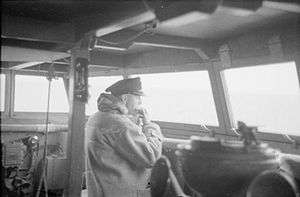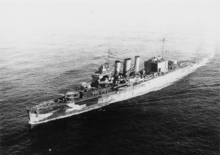HMS Suffolk (55)
.jpg) HMS Suffolk on the Tyne | |
| History | |
|---|---|
| Name: | HMS Suffolk |
| Builder: | Portsmouth Dockyard, UK |
| Laid down: | 30 September 1924 |
| Launched: | 16 February 1926 |
| Commissioned: | 31 May 1928 |
| Decommissioned: | 25 March 1948 |
| Identification: | Pennant number 55 |
| Motto: | Nous maintiendrons: 'We shall maintain' |
| Honours and awards: |
|
| Fate: | Scrapped, vessel was allocated to BISCO on 25 March 1948 and was scrapped at J Cashmore's (Newport, Wales)1948. |
| Badge: | On a Field Green a castle Gold hanging therefrom a key Silver. |
| General characteristics | |
| Class and type: | County-class heavy cruiser |
| Displacement: | 9,750 tons (9,010 t) |
| Tons burthen: | 13,450 tons (13,670 t) |
| Length: | 630 ft (190 m) |
| Beam: | 68 ft 3 in (20.80 m) |
| Draught: | 16 ft 3 in (4.95 m) |
| Propulsion: |
|
| Speed: | 31.5 knots (58.3 km/h; 36.2 mph) |
| Range: |
|
| Complement: | 700 |
| Armament: |
|
| Armour: |
|
| Aircraft carried: | Three aircraft with one catapult, removed in 1943. |
HMS Suffolk, pennant number 55, was a County-class heavy cruiser of the Royal Navy, and part of the Kent subclass. She was built by Portsmouth Dockyard, Portsmouth, UK), with the keel being laid down on 30 September 1924. She was launched on 16 February 1926, and commissioned on 31 May 1928.
History
Suffolk, like her sisters, served on the China Station, save for reconstruction, until the outbreak of the Second World War. She came home in 1939 and then patrolled the Denmark Strait in October 1939. In April 1940 Suffolk participated in the Norwegian Campaign. On 13 April 1940 the ship arrived at Tórshavn to commence the British pre-emptive occupation of the Faroe Islands. On 14 April 1940 Suffolk sank the German tanker Skagerrak northwest of Bodø, Norway.
On 17 April 1940, Suffolk and four destroyers, HMS Kipling, HMS Juno, HMS Janus and HMS Hereward, were sent to bombard the airfield at Sola, Norway. The operation had little effect and the retaliation from German bombers severely damaged the aft of the ship, forcing her to return to Scapa Flow.
Suffolk was out of action from April 1940 until February 1941 while she was repaired at the Clyde.
The ship was at this time part of the 4th Cruiser Squadron.

During May 1941 Suffolk was involved in the Battle of the Denmark Strait and the sinking of the German battleship Bismarck. Suffolk had engaged the battleship twice during the battle, making several salvoes on her. Using her radar, Suffolk was able to track the Bismarck through the Denmark Strait and maintained contact long enough for other units to vector into Bismarck's path.

After her repairs Suffolk served with the Home Fleet in Arctic waters until the end of 1942, then underwent a refit between December 1942 and April 1943 when "X" turret was removed and replaced with additional AA guns. On completion of this the ship was ordered to the Eastern Fleet, operating in the Indian Ocean until the end of the war.
In the summer of 1946 she was placed in unmaintained reserve until 1948. With the post-war economic difficulties of Britain hitting hard in 1947-48 the reserve fleet was quickly sold off, and Suffolk was decommissioned and allocated to BISCO on 25 March 1948. She was towed to J Cashmore's (Newport, Wales) where she arrived on 24 June 1948 and scrapping began immediately.
Notes
References
- Chesneau, Roger, ed. (1980). Conway's All the World's Fighting Ships 1922–1946. Greenwich: Conway Maritime Press. ISBN 0-85177-146-7.
- Raven, Alan; Roberts, John (1980). British Cruisers of World War Two. Annapolis, MD: Naval Institute Press. ISBN 0-87021-922-7.
- Rohwer, Jürgen (2005). Chronology of the War at Sea 1939–1945: The Naval History of World War Two (Third Revised ed.). Annapolis, Maryland: Naval Institute Press. ISBN 1-59114-119-2.
- Whitley, M. J. (1995). Cruisers of World War Two: An International Encyclopedia. London: Cassell. ISBN 1-86019-874-0.
External links
| Wikimedia Commons has media related to HMS Suffolk (55). |